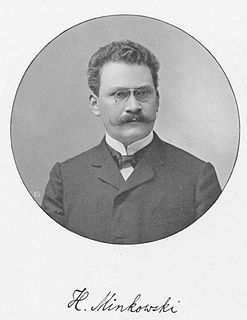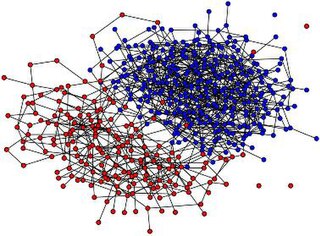In compact spaces
If K1,...,Kn are measurable subsets of a compact measure space X and their interiors pairwise do not intersect, then the collection [Ki] is a packing in X and its packing density is
- .
A packing density or packing fraction of a packing in some space is the fraction of the space filled by the figures making up the packing. In simplest terms, this is the ratio of the volume of bodies in a space to the volume of the space itself. In packing problems, the objective is usually to obtain a packing of the greatest possible density.
If K1,...,Kn are measurable subsets of a compact measure space X and their interiors pairwise do not intersect, then the collection [Ki] is a packing in X and its packing density is
If the space being packed is infinite in measure, such as Euclidean space, it is customary to define the density as the limit of densities exhibited in balls of larger and larger radii. If Bt is the ball of radius t centered at the origin, then the density of a packing [Ki : i∈] is
Since this limit does not always exist, it is also useful to define the upper and lower densities as the limit superior and limit inferior of the above respectively. If the density exists, the upper and lower densities are equal. Provided that any ball of the Euclidean space intersects only finitely many elements of the packing and that the diameters of the elements are bounded from above, the (upper, lower) density does not depend on the choice of origin, and μ(Ki∩Bt) can be replaced by μ(Ki) for every element that intersects Bt. [1] The ball may also be replaced by dilations of some other convex body, but in general the resulting densities are not equal.
One is often interested in packings restricted to use elements of a certain supply collection. For example, the supply collection may be the set of all balls of a given radius. The optimal packing density or packing constant associated with a supply collection is the supremum of upper densities obtained by packings that are subcollections of the supply collection. If the supply collection consists of convex bodies of bounded diameter, there exists a packing whose packing density is equal to the packing constant, and this packing constant does not vary if the balls in the definition of density are replaced by dilations of some other convex body. [1]
A particular supply collection of interest is all Euclidean motions of a fixed convex body K. In this case, we call the packing constant the packing constant of K. The Kepler conjecture is concerned with the packing constant of 3-balls. Ulam's packing conjecture states that 3-balls have the lowest packing constant of any convex solid. All translations of a fixed body is also a common supply collection of interest, and it defines the translative packing constant of that body.

In theoretical physics, a Feynman diagram is a pictorial representation of the mathematical expressions describing the behavior and interaction of subatomic particles. The scheme is named after American physicist Richard Feynman, who introduced the diagrams in 1948. The interaction of subatomic particles can be complex and difficult to understand; Feynman diagrams give a simple visualization of what would otherwise be an arcane and abstract formula. According to David Kaiser, "Since the middle of the 20th century, theoretical physicists have increasingly turned to this tool to help them undertake critical calculations. Feynman diagrams have revolutionized nearly every aspect of theoretical physics." While the diagrams are applied primarily to quantum field theory, they can also be used in other fields, such as solid-state theory. Frank Wilczek wrote that the calculations which won him the 2004 Nobel Prize in Physics "would have been literally unthinkable without Feynman diagrams, as would [Wilczek's] calculations that established a route to production and observation of the Higgs particle."
In mathematics, the Lp spaces are function spaces defined using a natural generalization of the p-norm for finite-dimensional vector spaces. They are sometimes called Lebesgue spaces, named after Henri Lebesgue, although according to the Bourbaki group they were first introduced by Frigyes Riesz. Lp spaces form an important class of Banach spaces in functional analysis, and of topological vector spaces. Because of their key role in the mathematical analysis of measure and probability spaces, Lebesgue spaces are used also in the theoretical discussion of problems in physics, statistics, finance, engineering, and other disciplines.

In mathematical physics, Minkowski space is a combination of three-dimensional Euclidean space and time into a four-dimensional manifold where the spacetime interval between any two events is independent of the inertial frame of reference in which they are recorded. Although initially developed by mathematician Hermann Minkowski for Maxwell's equations of electromagnetism, the mathematical structure of Minkowski spacetime was shown to be implied by the postulates of special relativity.
A conformal field theory (CFT) is a quantum field theory that is invariant under conformal transformations. In two dimensions, there is an infinite-dimensional algebra of local conformal transformations, and conformal field theories can sometimes be exactly solved or classified.
In numerical analysis and computational statistics, rejection sampling is a basic technique used to generate observations from a distribution. It is also commonly called the acceptance-rejection method or "accept-reject algorithm" and is a type of exact simulation method. The method works for any distribution in with a density.

In geometry, the Minkowski sum of two sets of position vectors A and B in Euclidean space is formed by adding each vector in A to each vector in B, i.e., the set
Bosonic string theory is the original version of String Theory, developed in the late 1960s. It is so called because it contains only bosons in the spectrum.
In mathematical physics, the conformal symmetry of spacetime is expressed by an extension of the Poincaré group. The extension includes special conformal transformations and dilations. In three spatial plus one time dimensions, conformal symmetry has 15 degrees of freedom: ten for the Poincaré group, four for special conformal transformations, and one for a dilation.
In statistics and information theory, a maximum entropy probability distribution has entropy that is at least as great as that of all other members of a specified class of probability distributions. According to the principle of maximum entropy, if nothing is known about a distribution except that it belongs to a certain class, then the distribution with the largest entropy should be chosen as the least-informative default. The motivation is twofold: first, maximizing entropy minimizes the amount of prior information built into the distribution; second, many physical systems tend to move towards maximal entropy configurations over time.
In image processing, computer vision and related fields, an image moment is a certain particular weighted average (moment) of the image pixels' intensities, or a function of such moments, usually chosen to have some attractive property or interpretation.
In conformal geometry, a conformal Killing vector field on a manifold of dimension n with (pseudo) Riemannian metric , is a vector field whose flow defines conformal transformations, that is, preserve up to scale and preserve the conformal structure. Several equivalent formulations, called the conformal Killing equation, exist in terms of the Lie derivative of the flow e.g. for some function on the manifold. For there are a finite number of solutions, specifying the conformal symmetry of that space, but in two dimensions, there is an infinity of solutions. The name Killing refers to Wilhelm Killing, who first investigated Killing vector fields.

In applied mathematics, the Joukowsky transform, named after Nikolai Zhukovsky, is a conformal map historically used to understand some principles of airfoil design.

In theoretical physics, the BPST instanton is the instanton with winding number 1 found by Alexander Belavin, Alexander Polyakov, Albert Schwarz and Yu. S. Tyupkin. It is a classical solution to the equations of motion of SU(2) Yang–Mills theory in Euclidean space-time, meaning it describes a transition between two different topological vacua of the theory. It was originally hoped to open the path to solving the problem of confinement, especially since Polyakov had proven in 1987 that instantons are the cause of confinement in three-dimensional compact-QED. This hope was not realized, however.
In measure theory, tangent measures are used to study the local behavior of Radon measures, in much the same way as tangent spaces are used to study the local behavior of differentiable manifolds. Tangent measures are a useful tool in geometric measure theory. For example, they are used in proving Marstrand's theorem and Preiss' theorem.
In mathematics and mathematical physics, raising and lowering indices are operations on tensors which change their type. Raising and lowering indices are a form of index manipulation in tensor expressions.

In graph theory, a random geometric graph (RGG) is the mathematically simplest spatial network, namely an undirected graph constructed by randomly placing N nodes in some metric space and connecting two nodes by a link if and only if their distance is in a given range, e.g. smaller than a certain neighborhood radius, r.
In mathematics, the spectral theory of ordinary differential equations is the part of spectral theory concerned with the determination of the spectrum and eigenfunction expansion associated with a linear ordinary differential equation. In his dissertation Hermann Weyl generalized the classical Sturm–Liouville theory on a finite closed interval to second order differential operators with singularities at the endpoints of the interval, possibly semi-infinite or infinite. Unlike the classical case, the spectrum may no longer consist of just a countable set of eigenvalues, but may also contain a continuous part. In this case the eigenfunction expansion involves an integral over the continuous part with respect to a spectral measure, given by the Titchmarsh–Kodaira formula. The theory was put in its final simplified form for singular differential equations of even degree by Kodaira and others, using von Neumann's spectral theorem. It has had important applications in quantum mechanics, operator theory and harmonic analysis on semisimple Lie groups.

In the mathematical theory of probability, the voter model is an interacting particle system introduced by Richard A. Holley and Thomas M. Liggett in 1975.
In astrophysics, Chandrasekhar's white dwarf equation is an initial value ordinary differential equation introduced by the Indian American astrophysicist Subrahmanyan Chandrasekhar, in his study of the gravitational potential of completely degenerate white dwarf stars. The equation reads as
In measure and probability theory in mathematics, a convex measure is a probability measure that — loosely put — does not assign more mass to any intermediate set "between" two measurable sets A and B than it does to A or B individually. There are multiple ways in which the comparison between the probabilities of A and B and the intermediate set can be made, leading to multiple definitions of convexity, such as log-concavity, harmonic convexity, and so on. The mathematician Christer Borell was a pioneer of the detailed study of convex measures on locally convex spaces in the 1970s.